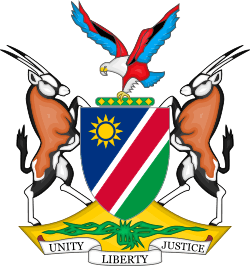Elections in Namibia
 |
|---|
| This article is part of a series on the politics and government of Namibia |
Elections in Namibia gives information on election and election results in Namibia.
Namibia elects on national level a head of state - the president - and a legislature. The president is elected for a five-year term by the people. The Parliament is bicameral in nature. Until 2014 the National Assembly had 78 members of which 72 were elected by direct popular vote using the proportional representation and a maximum of 6 non-voting members are appointed by the president. The members are elected for a five-year term. Since then the number of elected seats to the National Assembly was increased to 96 to allow for wider representation of the population.[1] The National Council has 26 members, elected for a six-year term in double-seat constituencies (regions). Namibia is a democratic but one party dominant state with the South West Africa People's Organisation (SWAPO) in power.
Opposition parties are allowed, but are widely considered to have no real chance of gaining power. Upon independence of Namibia the territory inherited a populace divided along ethnic groups, and political parties representing these ethnicities. While this is also true for SWAPO which was founded to represent the Ovambo people, the ruling party has garnered national support due to its role in the fight for independence. Opposition parties have had little success in national elections, and their representation in the lower house has been dwindling steadily.[1]
Current Results
President
| Candidate | Party | Votes | % | |
|---|---|---|---|---|
| Hage Geingob | SWAPO | 772,528 | 86.73 | |
| McHenry Venaani | Democratic Turnhalle Alliance | 44,271 | 4.97 | |
| Hidipo Hamutenya | Rally for Democracy and Progress | 30,197 | 3.39 | |
| Asser Mbai | National Unity Democratic Organisation | 16,740 | 1.88 | |
| Henk Mudge | Republican Party | 8,676 | 0.97 | |
| Ignatius Shixwameni | All People's Party | 7,266 | 0.82 | |
| Usutuaije Maamberua | SWANU | 5,028 | 0.56 | |
| Ben Ulenga | Congress of Democrats | 3,518 | 0.39 | |
| Jan Mukwilongo | Namibian Economic Freedom Fighters | 2,514 | 0.28 | |
| Total | 890,738 | 100.00 | ||
| Registered voters | 1,241,194 | 71.76 | ||
| Source: Notemba Tjipueja (1 December 2014): Official Announcement of Final Election Results of the 2014 Presidential and National Assembly Elections, Electoral Commission of Namibia | ||||
National Assembly
| Parties | Votes | % | Seats | +/– |
|---|---|---|---|---|
| SWAPO | 715,026 | 80.01 | 77 | |
| Democratic Turnhalle Alliance | 42,933 | 4.80 | 5 | |
| Rally for Democracy and Progress | 31,372 | 3.51 | 3 | |
| All People's Party | 20,431 | 2.29 | 2 | |
| United Democratic Front | 18,945 | 2.12 | 2 | 0 |
| National Unity Democratic Organisation | 17,942 | 2.01 | 2 | 0 |
| Workers Revolutionary Party | 13,328 | 1.49 | 2 | |
| SWANU | 6,354 | 0.71 | 1 | 0 |
| Republican Party | 6,099 | 0.68 | 1 | 0 |
| United People's Movement | 6,353 | 0.71 | 1 | New |
| Congress of Democrats | 3,404 | 0.38 | 0 | |
| Namibian Economic Freedom Fighters | 3,259 | 0.36 | 0 | New |
| Monitor Action Group | 3,073 | 0.34 | 0 | 0 |
| Christian Democratic Voice | 2,606 | 0.29 | 0 | New |
| National Democratic Party | 1,389 | 0.16 | 0 | 0 |
| Democratic Party of Namibia | 1,131 | 0.13 | 0 | 0 |
| Total | 893,643 | 100 | 96 | |
| Registered voters/turnout | 1,241,194 | 72.00 | – | – |
| Source: Notemba Tjipueja (1 December 2014): Official Announcement of Final Election Results of the 2014 Presidential and National Assembly Elections, Electoral Commission of Namibia | ||||
History
Before Namibian independence the territory was known as South West Africa. All elections until 1978 were only for Whites,[2] but even then several parties representing the indigenous population, among them SWAPO, were excluded.[3]
The first parliamentary elections were held in Namibia between 7 and 11 November 1989. These elections were for the Constituent Assembly of Namibia, which, upon independence in March 1990, became the National Assembly of Namibia. SWAPO won as expected, gaining 41 of the 72 seats, but not with the margin that was anticipated. Support for the opposition parties Democratic Turnhalle Alliance (DTA, 21 seats) and United Democratic Front (UDF, 4 seats) was strong in the former bantustans including Hereroland and Damaraland.[4] Since then, election results of the opposition parties have been dwindling steadily. For instance the DTA gained 15 seats in 1994, 7 seats in 1999, and 4 seats in 2004. As of 2017 the state of the opposition has been described as "on the verge of collapsing".[1]
Past elections
See also
References
- 1 2 3 Iikela, Sakeus (24 August 2017). "Where is the opposition ... when Swapo is fighting itself?". The Namibian. p. 6-7.
- ↑ Mudge, Dirk. The art of compromise: Constitution-making in Namibia (PDF). Konrad Adenauer Foundation. p. 126. Retrieved 23 September 2014.
- ↑ Dierks, Klaus. "Chronology of Namibian History, 1978". klausdierks.com. Retrieved 18 September 2014.
- ↑ Wren, Christopher S (15 November 1989). "Namibia Rebel Group Wins Vote, But It Falls Short of Full Control". The New York Times.